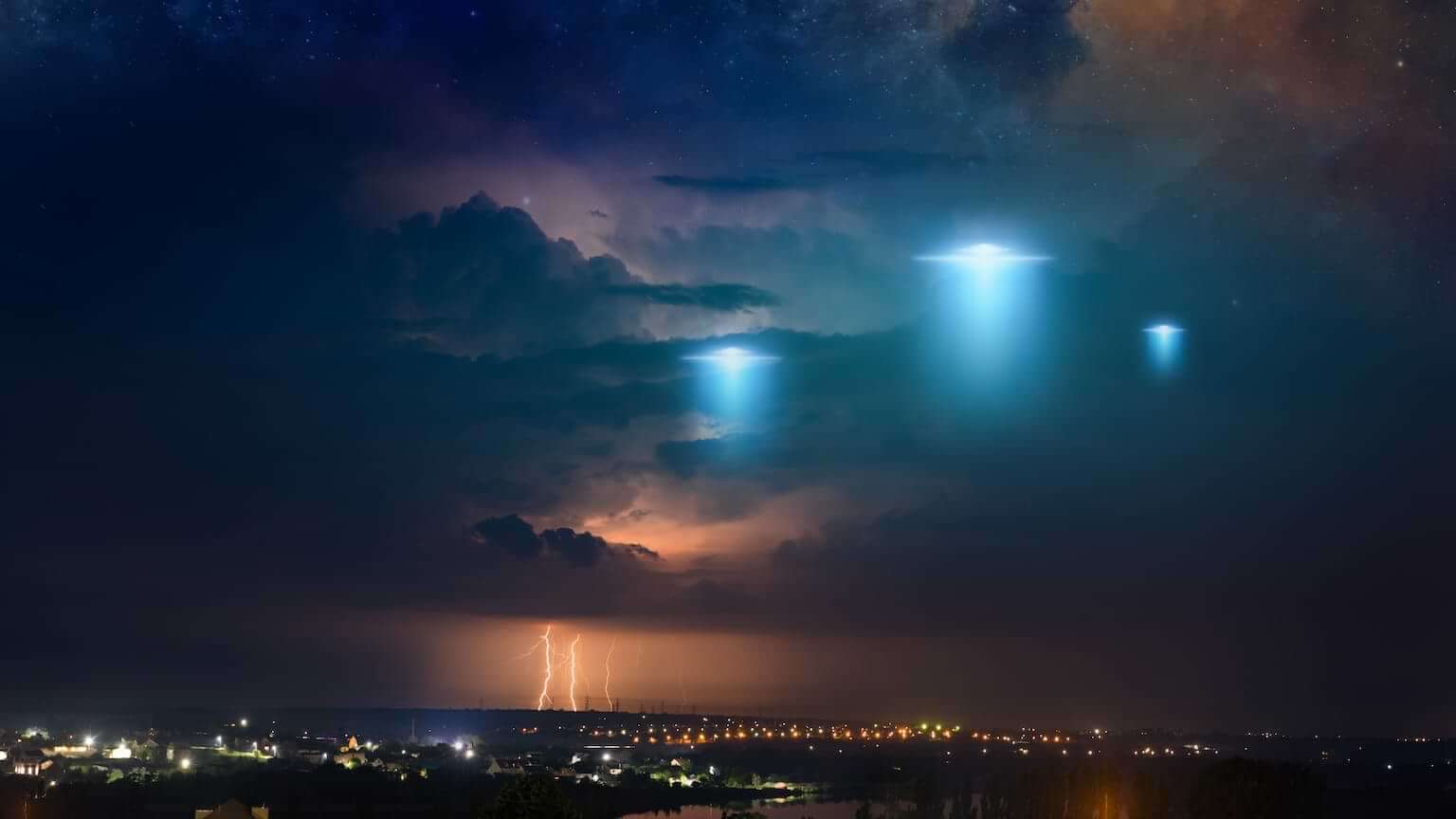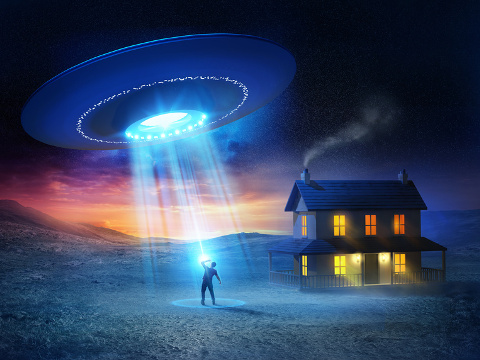
Extraterrestrial aliens spaceship fly above small town, UFO with blue spotlights in dark stormy sky. By IgorZh/stock/adobe.com
Belief can feel like a switch out of our control. We watch it flip on or off, especially for extraordinary things like UFOs.
If a man says that he saw a crashed alien spacecraft in a secret government facility and becomes famous through the fantastical tale, does the belief switch flip to on?
For most, it does not.
How about when several trained military aviation officers with advanced equipment tracking by different means—radar, infrared, in addition to sight—present a video recording, alongside government documents referring to the incident, with testimony that they’d tracked it before on multiple occasions, with further confirmation that the story is credible from the Pentagon? (And don’t forget the additional sightings in other locations of similar objects).
Then would the switch flip?
Are UFOs real?
Let’s make something clear: UFOs exist.
UFO stands for “unidentified flying objects.” The government recently retooled the phrase to “unidentified aerial phenomena” to accommodate the possibility of equipment malfunction or tricks of the light (UAP).
As long as the government hasn’t identified the phenomena, it remains “unidentified.” This means UFOs aren’t definitely aliens because then they would be identified. So UFOs aren’t necessarily extraterrestrial.
But the existing evidence demands action beyond a bureaucratic shoulder shrug. If the data shows what it seems to, then our national security could be frighteningly vulnerable.
Why hasn’t the government talked about UFOs more?
Ever since a shoddy program in the ’60s called Blue Book chalked up any sightings of UFOs to conspiracies or feebly explained them away, the government turned its nose up at UFOs. Congress and the Pentagon snickered for decades since and feared for their political reputation if they seriously entertained them.
Credible sightings did not receive attention because of the lingering stigma, although that has been unraveling for several years. As Senator Marco Rubio points out, UAPs are a threat to national security, whether they are Russian, Chinese, something else, or malfunctioning equipment.
Presidents Clinton and Obama have more or less acknowledged the existence of UFOs in the past. Trump’s National Intelligence Director John Ratcliff said that some UFO evidence seems to show objects with “technologies that we don’t have and frankly that we are not capable of defending against.”
Yet the government turned a blind eye to the sightings for years.
The atmosphere shifted after Christopher Mellon, Deputy Assistant Secretary of Defense of Intelligence, provided video footage of unclassified sightings to the New York Times. At that time, the program looking at UFOs was secretive and meager, called the “Advanced Aerospace Threat Identification Program.”
However, after that video leak, the government began working in earnest.
Does the evidence say UFOs are aliens?
As I characterized in the introduction, several declassified sightings used multiple sources of evidence including infrared, visual, and radar.
A few years ago, 60 Minutes ran a show on the videos released by the New York Times. They interviewed the two F-18 Navy pilots who saw the UFOs (one was a commander) and they discussed the activity of these objects in 2004 around their training area. They saw these “Tic Tac” UFOs on their radar nearly every day they trained over the East Coast.
Some experts believe this video, colloquially called “Go Fast,” was an optical illusion, and the angle of the viewing made the object appear to move much faster than it really did. But there are others that remain stubbornly unexplained.
The Pentagon systematically solved most UFO evidence that exists. Many were weather balloons, foreign spy drones, or airborne trash. Other videos have little data, so they don’t offer evidence of anything strange and can easily be explained as tricks of the light.
But other UAP reports from trained military personnel trickle into the new Unidentified Aerial Phenomena Task Force. The Office of the Director of National Intelligence heads up the task force.
The task force confirms their sightings are legitimate. Their 2021 Preliminary Assessment states that “a majority [80 of 144] of UAP were registered across multiple sensors, to include radar, infrared, electro-optical, weapon seekers, and visual observation.” In eighteen incidents, “observers reported unusual UAP movement patterns or flight characteristics” and the UAP “appear to demonstrate advanced technology.”
There were even eleven documented “near misses” by pilots. The modern “methods and means” of collecting the data are often military secrets, so the best data might remain classified.
What does the new evidence say?
The Director of National Intelligence released their annual report on UAPs in early 2022. In a little over one year, they garnered 366 more sightings, which brings the total reports cataloged to 510. They judged more than half of those “as exhibiting unremarkable characteristics.” Most likely, 163 were balloons, 26 were drones, and 6 were things like weather or airborne trash.
But that leaves over one hundred unsolved cases, again, many due to a lack of data. And, no, they did not announce first contact with any extraterrestrial life.
In the preliminary assessment from last year, they gathered 144 UFO reports from personnel for a period of seventeen years. In seventeen months, there have been 247 more reports. This massive jump in sightings is probably due to the conversation becoming de-stigmatized.
The All-Domain Anomaly Resolution Office will continue to scrutinize the UFO reports since they continue to pose a threat to national security and flight hazards.
Should I believe in aliens?
I recommend reserved openness. I’ve recently addressed “conspiratorial thinking” while writing about Alex Jones. The same rules apply here.
In this case, there is positive circumstantial and direct evidence, taken in context, that points to objects whose aerial travel greatly exceeds our known technology. That doesn’t mean ordinary explanations don’t exist; it just means that now we wait for more confirmation.
But, even if they are advanced craft, perhaps it’s a top, top-secret US defense program. Maybe they’re some kind of advanced spy drone.
And beware: anyone who claims certainty is probably selling little green plush toys for profit.
Extraordinary claims require extraordinary evidence.
Throughout all of this, experts avoid speculating about extraterrestrial life, although that’s thick between the lines. Regardless of its source, if the evidence bears that actual aerial crafts exist, Russian, Chinese, or “Alpha Centurian,” they could pose a huge security threat.
What if aliens exist? The “Dark Forest” theory
Dr. Jim Denison explains why he doubts the existence of aliens but also remains open in “Do UFOs exist? Logic, physics, Scripture, and gratitude for divine grace.”
Different theories attempt to explain why we haven’t encountered aliens yet (UFO sightings notwithstanding). Because we know an unthinkable number of stars exist (with some planets near us that appear more habitable for life than earth), statistically, alien civilizations ought to exist. Dr. Denison also discusses this puzzle, called the “Fermi Paradox.”
If aliens do exist, the most plausible explanation in my view is that their motivations and thinking deviate by orders of magnitude from ours.
The best treatment of extraterrestrial life I’ve encountered is in Cixin Liu’s The Three-Body Problem. It’s chilling, imaginative, nihilistic, brilliant, and presents the “Dark Forest” solution to the Fermi Paradox.
It goes like this: Vast numbers of interstellar aliens exist. However, revealing your location as a species in the vast cosmos means that a civilization far more advanced than you will almost certainly send a missile going nearly the speed of light into your sun and destroy your solar system to prevent you from evolving into a competitive civilization.
The one who shoots first survives, and the one who stays silent survives.
That is why aliens do not attempt to communicate across our galaxy and why we should stop trying. This video gives an entertaining breakdown. The Dark Forest theory is both fascinating and dreadful. Luckily, we don’t need to worry about the issue at the moment because our signals to outer space probably won’t reveal us to any advanced species any time soon.
What does the Bible say about aliens?
All of this assumes aliens exist.
Of course, we don’t know.
If they do exist, what does the Bible say about aliens? As Dr. Denison points out, “The Bible is a practical book. It does not tell us what happened to the dinosaurs or the size of the universe. Clearly, we don’t need to know if aliens exist in order to have the personal relationship with God for which we were created (John 1:12).”
When he says practical, he does not mean that all corners of the Bible are an instruction manual. It’s full of poetry, genealogies, wisdom, ancient law codes, and visions. But it is relevant to our relationship with God and living in the world with others. Apparently, aliens do not enter that picture. C. S. Lewis writes about aliens in his science fiction series The Space Trilogy, and perhaps fiction can help us think through the quandary.
Thinking ahead to the possibility of meeting aliens is an interesting theological exercise, even though the Bible doesn’t specifically address it. Dr. Denison concludes succinctly, “If aliens have free will, they need a Savior.”
If aliens do exist, we can trust that the wisdom of God will hold fast across the universe. We know his genius, love, and power does not end at the edge of our solar system.













